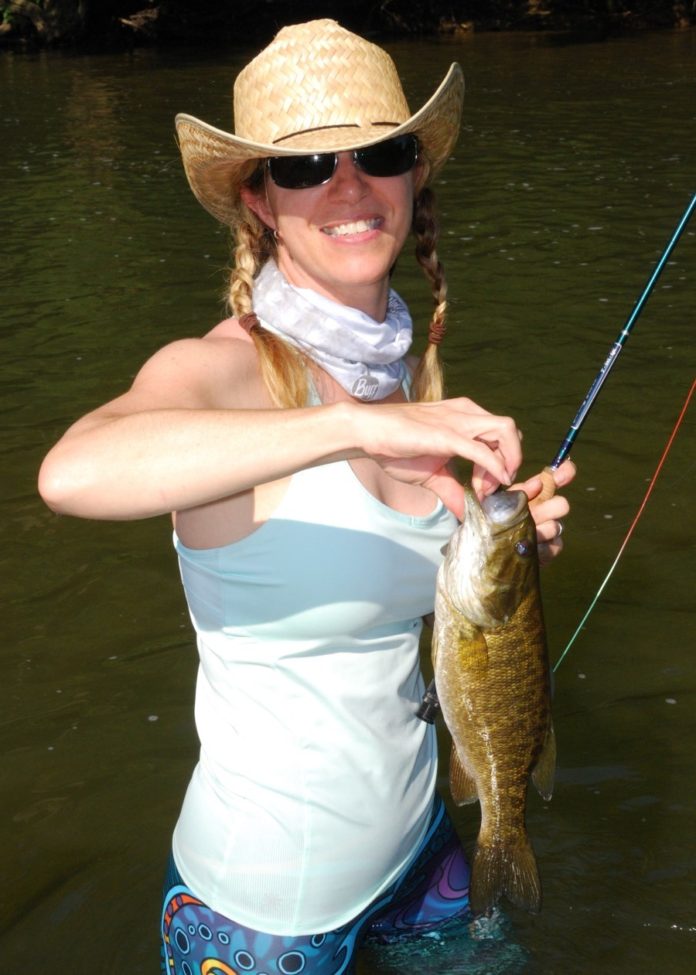FRANKFORT – Kentucky’s topography is laced with flowing, rock-bottomed streams that hold smallmouth bass. Most of the state east of the Tradewater River basin has streams that hold smallies.
The lower flows of early fall make it the best time to fly fish for smallmouth bass. The shallow water and gentle current allow the big and bulky flies needed for smallmouth bass to get down into the strike zone a little easier.
Fly fishing conjures images of tweediness and anglers holding wooden landing nets and casting pricey rods. None of these are necessary for stream smallmouth bass. A 5- to 7-weight forgiving moderate action rod with an old-school click and pawl reel is all you need. This is the most affordable fly fishing setup.
Getting your gear correct for stream smallmouth fly fishing requires ignoring many axioms related to fly fishing for trout. You don’t need tapered leaders and tippets. A 7- to 9-foot length of normal fluorocarbon line makes a great leader for fishing sinking flies. The cheaper fluorocarbon lines make better leader material as their stiffness helps turn over the bigger flies needed for smallmouth bass. An equal length of monofilament line makes good leader material for fishing topwater flies.
A regular weight-forward floating line works well for most situations, but deeper waters may require a sink-tip line to get the fly down to the smallmouths.
Many of the tenets of fly fishing for trout hold no quarter for stream smallmouth bass. You are not presenting tiny dry flies to smart wild trout in Yellowstone National Park. Some anglers call stream fishing for smallmouth, “bass combat.” You are presenting big flies to aggressive fish with tough mouths.
You can fill out a medium-sized fly box with enough flies for stream smallmouths. A few size 2 to 6 white or grey Clouser minnows, with as heavy a dumbbell weight as possible, along with some Near Nuff Crayfish flies in size 4 to 8 work well. An overlooked but deadly fly is a gold bead head lime green woolly bugger in size 4 or 6. Black is also a productive woolly bugger color. The tungsten bead versions of the woolly bugger help get the fly down to the smallmouth bass more quickly but cost more.
The previously mentioned flies designed for trout that work for smallmouth bass often employ a longer shank, J-style hook. These hooks work great for trout, but their narrow gape (gap) from the hook point to the shank often gives smallmouth bass a good chance to throw the fly on the jump. The narrow gape hooks stick a smallmouth in the toughest part of their mouths, leading to their escape.
Find flies with a wider gape hook. Fly anglers who enjoy tying their flies can tie their own wooly buggers, Clouser minnows or crayfish imitators with a hook more suitable for smallmouths.
Choosing productive water is vitally important when stream fishing for smallmouth with fly equipment. You need flowing, rocky water in early fall; the areas just upstream and just below stream drops hold the majority of the fish. The flowing, mid-depth shoals that held fish in May grow barren in September. An old rule of thumb is an area that has foam and bubbles on the surface from turbulence is a good place to fish.
Casting wind-resistant, heavy flies requires a different approach than those fly anglers accustomed to trout. Pull off enough line to shoot it a distance. Once a heavy Near Nuff Crayfish gets moving forward, it pulls out a good amount of line. Just one or two false casts and a hard stop on the follow-through get it started and momentum will take care of the rest. It is basically a “chunk and dunk” presentation.
Allow sinking flies to get down as deep as possible for stream smallmouth bass, they should strike the bottom occasionally. Trout anglers tend to over-strip their lines on the retrieve when fishing for stream smallmouth, pull in just enough line to keep a bag from forming in your line. You want the most “dead” presentation, keeping the line taut and following the progression of the fly with your rod tip in a low, strike-ready position.
This rod position allows for a stout hook set, a must for stream smallmouth, as they leap often with an uncanny ability to throw a fly.
September presents the best topwater fishing for stream smallmouth of the year.
Topwater presentations work well and provide incredible fun. This fishing will hook you on using a fly rod for stream smallmouth.
Longtime viewers of “Kentucky Afield” television remember former host Tim Farmer catch fat stream smallmouth on plain old cork poppers on fly gear. He used an inexpensive fly combo with an automatic reel and presented his cork poppers subtly, letting the current do the work. He caught many beauties as a result. The medium-sized cork poppers, not the small ones for bluegill or the larger ones for largemouth bass, work the best for stream smallmouth bass. Sneaky Pete topwater flies in white and black also draw strikes.
Anglers may access an excellent free brochure detailing Kentucky streams that hold smallmouth bass at the Kentucky Fish and Wildlife website at fw.ky.gov. Type “Kentucky Smallmouth Bass Streams” in the search bar at the top of the page.
The best time of the year for catching stream smallmouth bass with fly gear is upon us. Get out and enjoy this fun way to fish this fall. Winter will be here before you know it.
Credit: Source link





























